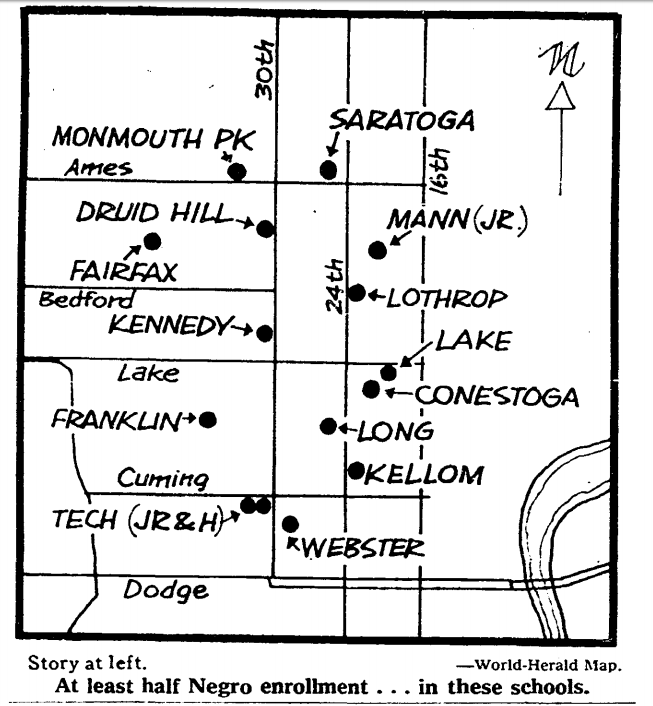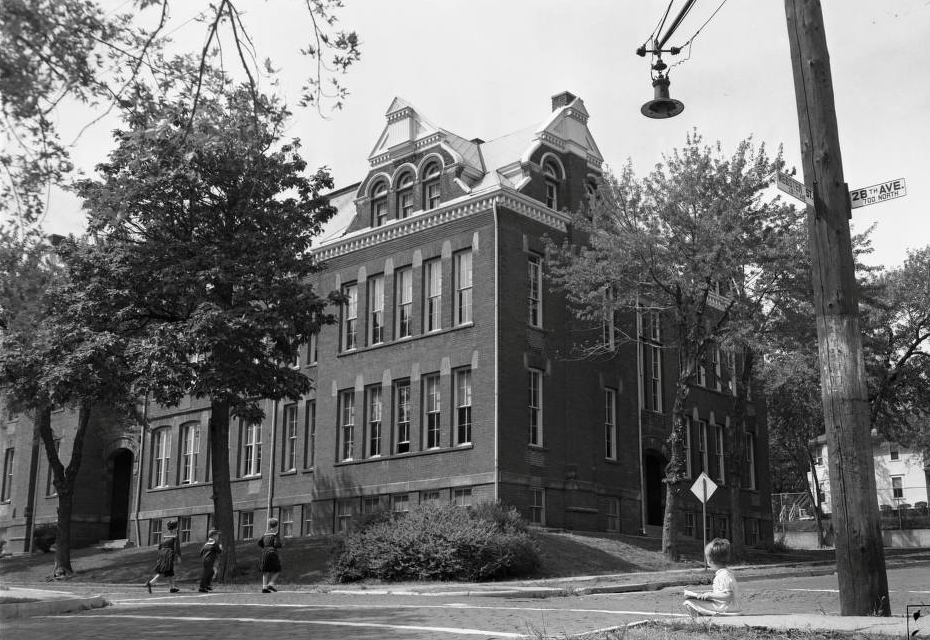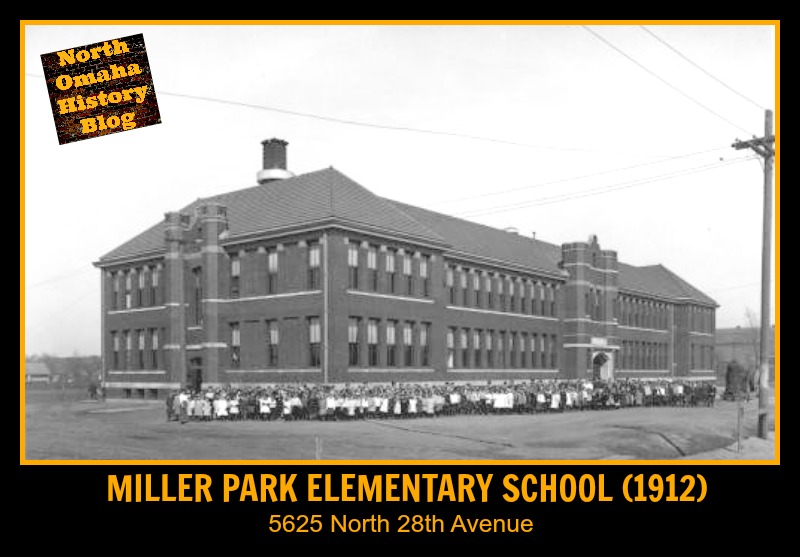In the 1870s, the Omaha public school district was catching up with needs around the city for more schools. Within a decade, the district went from one school to 15 and was trying to teach more students than ever. This is a history of one of those buildings called the Webster School.
Building Webster School
“In its days, an architectural wonder…”
—Omaha World-Herald, September 2, 1956

The Webster School was built in 1887 and 1888 at 616 North 28th Avenue on the southeast corner of North 28th Avenue and Webster Streets. The Omaha school district held a nationwide competition with a $500 award for the winning design for the school. Won by local architect John L. Latenser, Sr., this was his first design contract with the district before becoming a main architect for the district’s schools. Eventually, Latenser Sr. designed more than a dozen across the city over the next several decades. North of Dodge Street, he designed the Saunders, Dundee, Central High, Cass Street, Saratoga, Benson West, Miller Park, and Central Park schools. In anticipation of the city’s growth, the school was built in the western hills of Omaha before there were many houses around it. The corner of North 28th and Webster was referred to as being “in the country.”
Presumably named after early American statesman Daniel Webster (1782-1852), the school was regarded as an “architectural wonder.” Laid out in a style similar to a factory, Webster Grade School was a two-and-a-half story brick building with kindergarten through eighth grades when it opened. Later seventh and eighth grade were moved out, and it had kindergarten through sixth grades. In 1887, the building cost nearly $40,000. For the first decade of its existence, the school had no central heating plant and on the most severe days of winter they were sent home because of the cold in the building. Throughout its existence from 1888 to 1969, the school regularly had between 200 and 350 students, with sometimes as many as 400 students and as few as 150.
In later years, students distinctly remembered the fact that the building had no cafeteria, no gym, and only steam heat from giant old radiators. There were coat halls in every classroom and a gravel playing area with no playground. Without a cafeteria, the school was an open campus at lunchtime with students either going home or to a cheap eatery nearby. There were assemblies held in the school’s hallways and staggering steps leading to the building on a hill, as well as fire escape slides on the back of the building. In 1945, the school had 180 girls who all shared one bathroom that had 16 toilets.
Sadie Pittman was the first principal of the school, and served from 1888 to 1916. Between then and 1942, the principals were Mary Austin, Clara Cooper, Fannie Myers, Mabel Reed, Pattie Whitehouse, and Margaret Corcoran.
The Life of a School

A fire struck the school’s basement in 1889. In February of that year, the janitor called firemen to the building. They found flames on the walls, partions and ceilings of the basement, and projected a large fire. A second alarm was sounded and the firemen confined the fire to the basement. With damage limited to burning a “small hole” through the floor in a first grade room, the cost of the fire was just $300. A cause for the fire was never named.
Originally located in a predominantly Irish neighborhood served by the St. John’s Catholic parish, the Webster School became well integrated with different ethnicities and income levels. From the 1870s through the 1910s, there was a brickyard next to the school extending to Lincoln Boulevard. Today the Hilman Dairy is there. The expected rivalry between the St. John’s and Webster was written about between 1900 and 1930, with ongoing battles in basketball, baseball and more covered in the newspaper.
In the first quarter century of its existence, the school had a pump organ play while students went to classes in the mornings. There was attendance, the Pledge of Allegiance, and other regular activities. In 1904, the school was closed for more than a month when a scarlet fever epidemic struck the surrounding neighborhood. After it abated, the school was opened again.
World famous silent movie star Harold Lloyd (1893-1971) was a 12-year-old student at Webster School when he became an actor in local theater. Eventually cited as “one of the most influential film comedians” in the era, Lloyd visited the school in 1950 after he was famous and wealthy. Tricking the local media about leaving town, he came into the building after his announced departure. He walked around with staff and found his old classroom. Searching for a desk where he carved his initials, he didn’t find it but still said he enjoyed his return. Although he only attended Webster for a few years, it left a good impression on him. Much earlier than his visit, in 1942 students at the school mailed a letter to Lloyd’s press agent, who replied, “Lloyd is emphatic in recalling that his days at Webster were among the happiest of his youth. He attended seventh and eighth grades there… It was while at Webster that he was smitten with the theatrical bug. He was a master at makeup and on Saturdays half the kids in the neighborhood used to run around in makeup which Lloyd put on them.”
The school was cited by inspectors as one of the smokiest buildings in Omaha in 1926. “The board of education has been installing improved smokers in many schools, but has not yet made the rounds of the 50 large buildings. Webster School is said to be one of the chief smoke offenders.”
In 1929, the school district considered closing Webster along with several other redundant buildings. However, since the nearby Yates Grade School was overfilled, those students were sent to Webster to balance enrollment. An innovative learning program called the Individual Progress Department was started at Webster that year. With the goal of seeking “to make useful individuals of children who are manually minded rather than academically minded,” eight students from Webster participated. It expanded and eventually served more than 800 students throughout the district, and by 1956 claimed a 75% success rate of students who “established themselves as useful citizens leading constructive lives.”
![The caption from this November 7, 1945 newspaper clipping says, "This is the 'gymnasium' at Webster School, with one mat for equipment. The school has 370 pupils. The building was errected in 1886 [sic], and some physical conditions are the same today. For example, there is a small fireplace, not in use, in the boys' restroom."](https://northomahahistory.files.wordpress.com/2022/10/screen-shot-2022-10-11-at-2.47.52-pm.png)
Throughout the 1930s, students at the school were celebrated for an innovative project. The newspaper said, “Ten young shoemakers, students in vocational education classes at Webster School, were awarded certificates by the Superintendent…” The class was sponsored by the Omaha Kiwanis, and according to the teacher, in 1938 15 students spent 2,377 hours repairing 1,400 pairs of shoes.
The area had new residents from Poland as well as refugees from Germany and Russia starting in the 1930s. Stories in the newspaper sound like some of the children suffered from post-traumatic stress while at school from that pre-World War II era.
Students at the school created a victory garden to support war efforts in 1942. The garden was located in a vacant lot across the street from the building. Holding a coat hanger school early in the school year, they raised money to buy seeds with students in all grades raising them indoors in “old tea cups.” Volunteering to take care of the garden during the summer, “the crop is to be given to needy families in the Webster district.” Using supplies from the Works Progress Administration CCC Camp at Carter Lake, they put in rock gardens, dirt and stone donated from the Bloom Monument Company.
Early in 1950, the school board received a complaint about “deplorable conditions” at Webster School. A letter to the editor said, “Webster School is… so deteriorated that the library ceiling is ready to fall down. Rooms are in need of bright new paint; the only drinking water is in the basement and the lavatories are a sight. People should see where our children have gym!… The morale of children at Webster is very low because they have nothing but a sagging building. Try and brighten the spirits of children in a neighborhood such as this!” The board referred the issue to Superintendent Harry Burke, who denied the ceiling was collapsing in one section of the building. The board president called the building “livable,” and said it was “25% below average.” An open house later that year brought the public in for a public performance and tours. More than two years later, the school had new drinking fountains and a hot water installed, and in 1953 it was painted thoroughly and extensive repairs were made. The district transferred students to Webster from Kellom School and Long School in the early 1950s in order to balance out student populations more effectively. However, Webster grew too quickly and was soon overfilled.
There was a small electrical fire at the school in 1952 that barely caused any damage.
By the early 1960s, the majority of the school’s student population was African American. When the school closed, some memories focused on the integrated feeling at the building that had Christian, non-religious, Jewish, and Black students throughout much of its existence. It was regarded as one of Omaha’s “Black schools” though, because it was a building with a noticeable percentage of Black students that buildings in other areas didn’t have. After its closure, the Omaha World-Herald kept track of the impact of the presence of African American students who once attended Webster. Of particular interest was the Yates School, which according to the paper had two Black students in 1966 and 174 in 1969 after Webster closed.

From 1961 to 1967, a private company called the Haven Academy offered classes for “about 20 emotionally disturbed youngsters” in two rented classrooms at Webster School. With funding from the Nebraska Legislature, the classes were considered essential and highly innovative. In 1967, the district took on the classes after funding was denied to the Haven Academy. They also started a new program for similar students at Fontenelle School.
In 1966, student hunger was cited as a major challenge to learning at the school. Principal Agnes Nelson said she “keeps milk and crackers on hand” for students who complain about headaches and stomachaches. The first question she would ask was, “What did you have for breakfast?” and “quite often the answer is ‘nothing.’” The federal free breakfast program was started later that year.
The Webster School was over-enrolled for over 20 years before it closed. With the secretary’s office in the front hallway without a dedicated room, it’s no surprise that the building’s classes were packed, too.

When it closed permanently after the 1968-69 school year, at 88-years-old, Webster was the oldest school building in OPS. Within a small timeframe, three schools in the neighborhood were closed including Webster, Central Elementary, and the Catholic St. John’s School were all closed. Located in a neighborhood that no longer exists, Webster Elementary School was demolished to make room for a parking lot at the Saint Joseph Creighton University Hospital in 1969. Much of the neighborhood around it was demolished to make room for the hospital, Interstate 480, the North Freeway, and the growth of Creighton University. Other schools north of Dodge that closed that year included Long, Dundee and Saunders.
Today, there is no sign that the Webster School ever existed.
Notable Alumni
Some of the most notable alumni of the school included
- Harry Tukey (1877-1952), a leading real estate mogul in Omaha and former School Board president
- Sam Beber (1901-1976), former attorney and founder of the B’nai B’rith Youth Organization
- Louis C. Nash (1881-1946), president of a large department store in Omaha
- Harold Lloyd (1893-1971), comedian and actor
You Might Like…
MY ARTICLES ABOUT THE HISTORY OF SCHOOLS IN NORTH OMAHA
GENERAL: Segregated Schools | Higher Education
PUBLIC GRADE SCHOOLS: Beechwood | Belvedere | Cass | Central Park | Dodge Street | Druid Hill | Florence | Fort Omaha School | Howard Kennedy | Kellom | Lake | Long | Miller Park | Minne Lusa | Monmouth Park | North Omaha (Izard) | Omaha View | Pershing | Ponca | Saratoga | Sherman | Walnut Hill | Webster
PUBLIC MIDDLE SCHOOLS: McMillan | Technical
PUBLIC HIGH SCHOOLS: North | Technical | Florence
CATHOLIC SCHOOLS: Creighton | Dominican | Holy Angels | Holy Family | Sacred Heart | St. Benedict | St. John | St. Therese
LUTHERAN SCHOOLS: Hope | St. Paul
HIGHER EDUCATION: Omaha University | Creighton University | Presbyterian Theological Seminary | Joslyn Hall | Jacobs Hall | Fort Omaha
MORE: Fort Street Special School for Incorrigible Boys | Nebraska School for the Deaf and Dumb
Listen to the North Omaha History Podcast on “The History of Schools in North Omaha” »
BONUS











Leave a comment